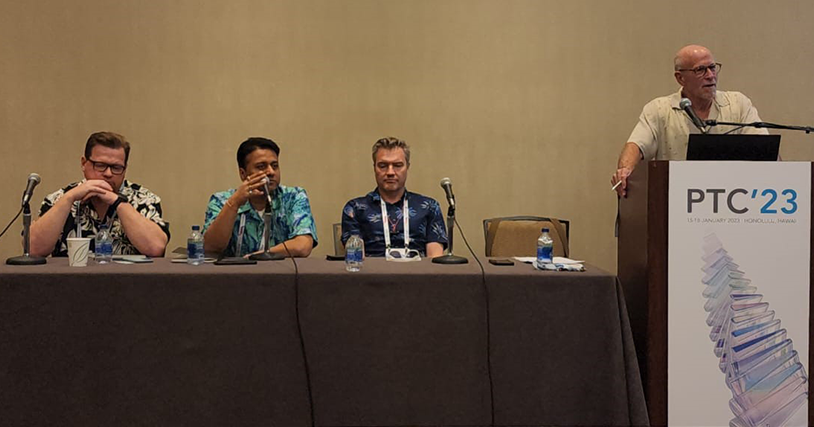
The Pacific Telecommunications Council’s (PTC) annual conference is a strategic springboard for the global communications industry, providing attendees with opportunities to plan, network and discover what lies ahead for the Information and Communications Technology (ICT) industry. This year’s PTC’23 was held in Honolulu, Hawaii and attended by global telecom and mobile network operators, tower companies, solution providers, satellite operators, equipment manufacturers, internet service providers, and investment funds and banking institutions.
I joined several colleagues from around the world on a panel to discuss A New Era for Satellite Connectivity––from Broadband to Direct to Device. With direct satellite-to-device connectivity, users can communicate directly via the satellite to a device without the need for a terrestrial gateway. For MNOs, this means being able to provide secure connectivity to existing customers, enabling them to roam outside the terrestrial mobile network.
Following the discussion, we opened the floor up to questions. Here’s what attendees wanted to know.
What is the real addressable market for satellite, where direct satellite-to-device competes with or complements “traditional” architectures?
According to ABI Research, the worldwide satellite service addressable market is expected to top 330 million premises by 2026; 169 million of them in the APAC region! The addressable market for satellite continues to grow––whether direct to home, shared VSAT solutions or extending mobile network reach. And that doesn’t include enterprise networks. Direct to device is exciting and interesting, but still very basic at this point. The ultimate will be when we’re able to deliver a more robust connected experience anytime, anywhere, on any device––satellite will be essential to realizing that vision.
What is the role of government and the Universal Service Obligation (USO), which provides a baseline level of service to every resident of a country? Is government support mission critical?
Globally, governments acknowledge the need to deliver broadband to every village. This is equally true for economies in Asia Pacific. Indonesia is a good example where the Ministry of Communication has created a very effective organization called BAKTI to use the USO funds to connect unconnected villages. The government has provided direct funding by Leasing Bulk Capacity [30Gbps] on high throughput satellites (HTS). Using this they serve over 12,000 sites for 4G backhaul and internet to villages. They didn’t stop there, investing in over 200 Gbps of bandwidth in two satellites that will launch in the second half of 2023. This capacity will enable the government to further connect 150,000+ locations (schools, police stations, health clinics, government offices). The Indonesian government has used innovative Public Private Partnership models to make this a reality. Government attention accelerates programs with much needed financial support; creates a dominant user for the capacity by spurring demand; and acknowledges the urgency in delivering broadband connectivity.
For direct-to-device communications, is narrowband and SOS messaging enough?
Narrowband systems, which often support public safety and emergency communications, typically have lower data rate transmissions and are ideal for fixed-location and apps that transmit over short distances. For direct to device, that capability is just the beginning. People won’t be satisfied until they have high speed connectivity everywhere, all the time. How they get that connection––by satellite, wireless or fiber––will become invisible and immaterial to the user.
According to NSR, this emerging direct satellite-to-device market is expected to reach $35 billion by 2030, launching an exciting time for satellite communications and terrestrial mobile networks around the world.
Are regulatory barriers getting easier?
Yes! And technology is making it easier to comply. For example, the Hughes JUPITER™ system allows customers to build distributed or centralized architectures. Our gateways are highly dense. These capabilities allow them to build in-country infrastructure required to meet regulatory requirements.
If our panel’s lively Q&A session is any indication, direct satellite-to-device connectivity represents a groundbreaking new opportunity for satellite communications that is sure to remain a hot topic in 2023 and beyond.